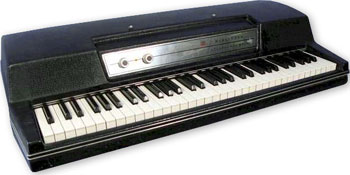|

Weapon of Choice: Wurlitzer
General description
The Wurlitzer piano is usually a 64-note instrument
whose keyboard range is from A an octave above the lowest note of
a standard 88-note piano to the C an octave below the top note of
an 88-note piano. Tone production in all models comprises a single
steel reed for each key, activated by a miniature version
of a conventional grand piano action and forming part of an electrostatic
pickup system using a DC voltage of 170v. A mechanical sustain pedal
similar to that of a conventional piano is fitted.
History
Inventor Benjamin Miessner had designed an amplified conventional
upright piano in the 1930s, and Wurlitzer used his electrostatic
pickup design, but replaced the strings with struck steel reeds.
The instrument entered production in 1955 as the EP-112 and continued
to be produced in various forms until about 1982 when production
of the EP-200A ceased.
Follow this link to see the mechanism in action:
keyboardmuseum
-- click the key with your mouse
to hear
Variations
Most Wurlitzer electric pianos are portable models with removable
legs and the sustain pedal attached via a Bowden cable; console,
"grand" and "spinet" models were also produced
with a permanently attached pedal.
Portable models
The earliest versions were the "100" series;
these had a case made from painted fibreboard or wood and were fitted
with a single loudspeaker mounted in the rear of the case. Apart
from the very first models, the portable Wurlitzer pianos featured
a tremolo effect with fixed rate but adjustable
depth. Models produced until the early 1960s used valve
circuitry; the 140B was the first solid-state model.
The next model, the 145 was replaced in 1969 by the plastic-bodied
200, a much lighter instrument with two loudspeakers facing the
player. This model was updated as the 200A a few
years later and continued in production into the early 1980s. The
200 was available in black, dark "Forest Green", red or
beige. The 200A was only available in black. The
last version to be introduced was the 200B in 1978; this was visually
identical to the 200A but was designed to be powered by a pair of
medium-tension (85v) rechargeable batteries; it had no internal
speakers.
Console models
One important role for the Wurlitzer piano was as a student
instrument in school and college music labs, and non-portable
console versions were made for this purpose. Those usually seen
resemble a beige or light green Model 200 mounted on a matching
pedestal containing a loudspeaker, headphone niche and sustain pedal.
On these models there is no tremolo (although later models simply
have the facility disabled). Some of these models were given the
designation 206/206A. Many console models have recently been modified
to 200/200A specification for use on stage. Rarer than the student
models are the teacher consoles, featuring multiple monitor/mute
switches and, in some cases the facility to add a large illuminated
display panel operated via the keyboard.
Other models
Spinet versions
Since production began, small numbers of wood-cased spinet-style
instruments were made for domestic use. These usually had an upright-piano
style soft pedal (actually an electronic attenuator) as well as
the sustain pedal. The mechanism of these pianos is identical to
that of the contemporary portable version.
Butterfly Baby Grand
The 200 uniquely had a domestic sister model called the "Butterfly
Baby Grand", a semicircular wooden-cased piano with twin quadrant-shaped
lids angled above horizontally-mounted loudspeakers.
106P
A rare version, and the only known model not to have 64 keys is
the 106P, a 44-note classroom model with a plastic case, no controls,
one loudspeaker and no sustain pedal. The 106P was available as
a set of eight (model 106) on a folding frame, forming a portable
keyboard lab. This model appears to date from the early 1970s and
was available in orange or beige.
Sound
Compared with its erstwhile rival, the (Fender) Rhodes electric
piano, the Wurlitzer has a brighter, more hollow sound. When played
gently the sound can be quite sweet and vibraphone-like, becoming
more aggressive with harder playing, producing a characteristic
slightly overdriven tone usually described as a "bark".
In a pop or rock band setting with guitar(s), bass and drums the
Wurlitzer has a distinctive and clear sound where a Rhodes would
tend to blend in. However it has also been used successfully in
MOR ballads and even country music.
The Wurlitzer electric piano was one of a series of electromechanical
stringless pianos manufactured and marketed by the Rudolph Wurlitzer
Company, Corinth, Mississippi, USA. The Wurlitzer company actually
called the instrument (inaccurately in retrospect) the "Electronic
Piano", but musicians usually describe it correctly as an electric
piano.
-- courtesy of wikipedia
|
